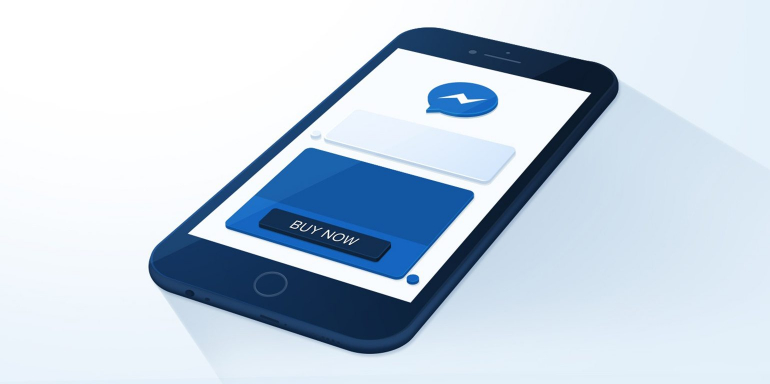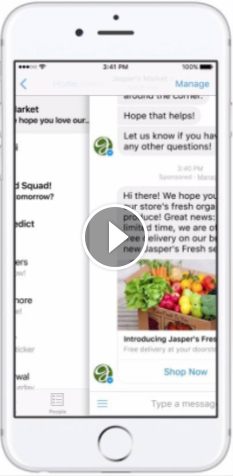Want a free cocktail?
Absolut’s new Facebook Messenger bot wants to know.
If the answer’s “yes” and you live in one of four US states, you can now contact the company on messenger and choose one of three drinks, then redeem it free at a nearby location with a promotional code:
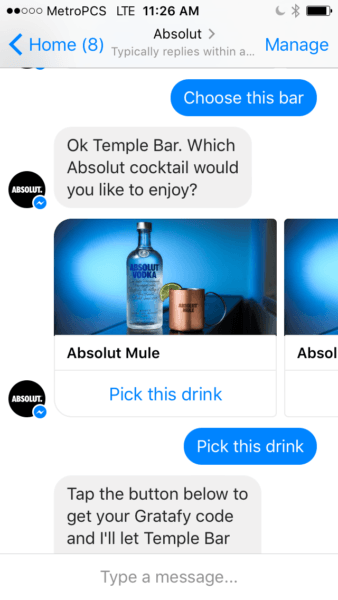
According to Absolut, the campaign has boosted brand awareness impressively — partly due to a new ad type that allows over 30,000 Facebook Messenger bots to do something they once couldn’t on the social network.
How Facebook Messenger bots used to work
Like they were with Instant Articles, Facebook was strict about brands’ use of bots from the get-go. At first, some were restricted to sending content like news only. Then, they could deliver promotional offers, but only after the user requested it by contacting the business via messenger — and only within the first 24 hours of that request.
But now, Facebook is loosening those restrictions, thereby opening up more opportunities for brands to engage with users on the social network — starting with “messenger as a destination” News Feed ads.
Messenger as a destination News Feed ads
One of the most important requests we received from developers and businesses building on the Messenger Platform is the ability to promote their experience. This is why I’m thrilled to announce the roll-out of News Feed ads that open Messenger conversations.
The new ad type gives messenger bots the ability to do something that, up until now, they weren’t allowed to: start a conversation.
Now advertisers will be able to use Facebook’s pinpoint targeting capabilities to find people likely to be interested in their bot, and serve them an ad that opens a conversation with it when clicked.
They look exactly like image ads, only they feature a call-to-action reading “send message.”

Joaoa Rozario, VP of Marketing at Absolut, claims he’s seen notable results so far with the new format.
Using News Feed ads to open conversations in Messenger allows Absolut to move beyond the call to action – it’s a call to conversation, which ultimately leads to a conversion. It’s a novel way to use Facebook ads to drive consumers from content to commerce. So far, our activation rate has exceeded execution benchmarks by 2x and we’re looking forward to continued increases in activations driven by News Feed ads over the key holiday period.
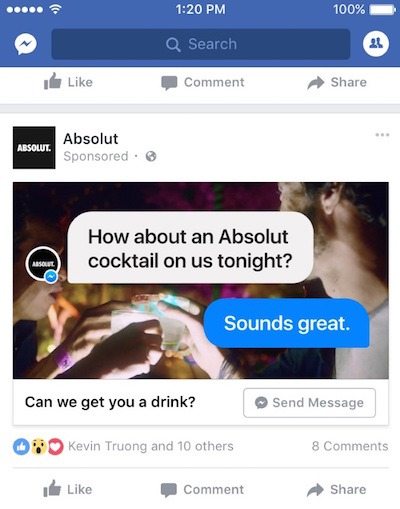
But, Facebook acknowledges that driving people to a messenger conversation isn’t enough.
“We want to make sure businesses and brands building for the Platform can manage the entire lifecycle of their customers,” added Marcus. “This is where sponsored messages come in.”
Sponsored messages
Sponsored messages boost the potential for engagement with customers – or rather, re-engagement. The new update now offers brands the ability to reach back out to users who have previously initiated a conversation with their bot.
If your business has a thread open with a Facebook user, it can reach back out to them with a message that will look something like what you see from CNN here:

From here, users can click into your conversation to reply, at which point you can continue it with them on Facebook, or drive them to relevant post-click landing pages (click through here to play the short video):
Remember, though, Facebook’s priority is still user experience. And so, these sponsored messages come with a few catches.
First, the obvious: You can’t send one to a user that hasn’t engaged with your bot before. These are strictly to re-engage users who have initiated a conversation with your bot at some point, whether organically or through a News Feed ad.
Second: To keep brands from getting spammy, Facebook has allowed users to block your bot from sending them messages if they don’t want to receive your content.
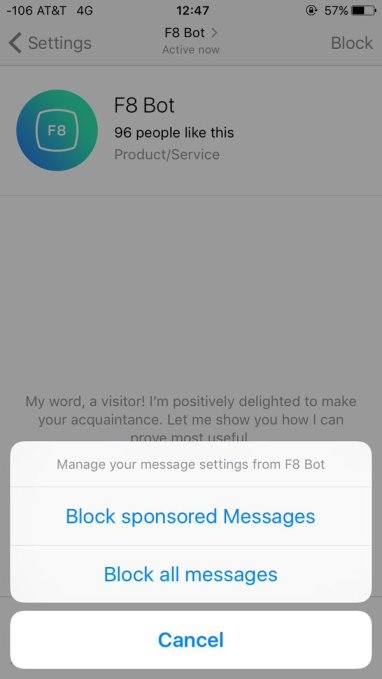
The goal for Facebook with these messages, according to Marcus, is to create a “high quality, high signal, low noise experience for everyone.” So keep your messages spam-free to risk losing a customer — or even worse — being penalized by Facebook.
How to create click-to-message News Feed ads and sponsored messages
To benefit from a sponsored message or click-to-message Facebook ad campaign, you’ll obviously first need a bot. If you have one, then you can learn how to use the social network’s ad creator, Power Editor, or API to create a sponsored message here.
To build your first click-to-message News Feed ad, use the Power Editor or ads creator tool. We recommend learning how by following this step-by-step guide from Jon Loomer.
Other important Facebook Messenger platform updates
The new Facebook Messenger Platform 1.3 brought click-to-message News Feed ads and sponsored messages, but also some other significant updates. According to the social network:
- Reference Params for M.me Referral Links: Developers can now add reference params to their m.me vanity link, which will allow them to figure out where the people using their bot are coming from.
- Deep Linking for M.me Referral Links: With the new reference param, developers can also deep link someone into a particular bot experience. For instance, if someone clicks on the m.me link from a particular section within a website, a developer can now send a message that references that section.
- List Templates: Developers can now display information in a simple but effective way. Add a CTA or image to items in the list to customize its look.
- Pre-Checked Plugin: Developers can now add a checkbox plugin to easily allow Facebook users to opt into a Messenger conversation with their business.
- Better Search Results: Facebook is in the process of creating a more powerful search engine that makes it easier for people to find bots useful to them.
How to use the new Facebook Messenger ads
You don’t have to be a developer wiz, or even have one on staff to create your own Messenger bot. There are already businesses out there that can create a basic one for an affordable sum, and even platforms that allow you to build one yourself without coding knowledge.
On the other hand, if you’re looking for something worthy of a Loebner Prize (the award given to the most human-like chatbot), you could easily spend upwards of $250,000.
What direction you choose to go in ultimately depends on your budget, where your customers hang out online, and if a chatbot fits into your marketing strategy. While a customer service messenger bot may make sense for a retail company, it might not for a SaaS business.
Keep in mind, though; you can capitalize on the over 1 billion Facebook Messenger users without dedicating too much time and resources to a chatbot. A messenger bot that processes basic transactions, like the one from 1-800 Flowers, can be built more affordably.

Once developed, these basic bots have the potential to boost your bottom line without much upkeep. A few months after creating theirs, 1-800 Flowers noticed that 70% of their new customers came via Facebook Messenger.
Combined with the new platform updates, you can create a mostly automatic Facebook conversion funnel. It might look a little like this:
- Target your customers with messenger-as-a-destination ads.
- Engage your audience with a basic messenger bot that can notify them of new products or updates, and drive them to relevant post-click landing pages where they can claim your offers.
- Add the Meta pixel to your target post-click landing pages and on their corresponding ‘thank you’ pages.
- Create a remarketing campaign that serves sponsored messages to audiences that have visited your post-click landing page but not continued to your “thank you” page to re-attempt to convert them with your bot. The advantage of using a sponsored message over a regular ad here is that your prospect will see a notification in their Facebook inbox when you reach out to them about your offer. With a regular News Feed or sidebar ad, they won’t.
- Get your new leads to convert again by serving sponsored messages to audiences that have visited your “thank you” pages to offer them an additional resource that pushes them further down the marketing funnel. For a product, this might be a relevant upsell or cross-sell. For a free resource like an ebook or tip sheet, it might be a demo or case study.
And you can do all this with little maintenance. Once it’s set up, it will guide your prospects to conversion almost automatically.
Will you use Facebook Messenger marketing?
There are over 1 billion messages sent from Facebook Messenger users to businesses each month. Are you using the platform to market your product or service? Will you take advantage of the new ad types?
Turn ad clicks into conversions, create dedicated, fast-loading post-click pages for every offer. See how you can provide audiences with unique post-click landing pages by signing up for an Instapage Enterprise Demo today.

See the Instapage Enterprise Plan in Action.
Demo includes AdMap™, Personalization, AMP,
Global Blocks, heatmaps & more.
